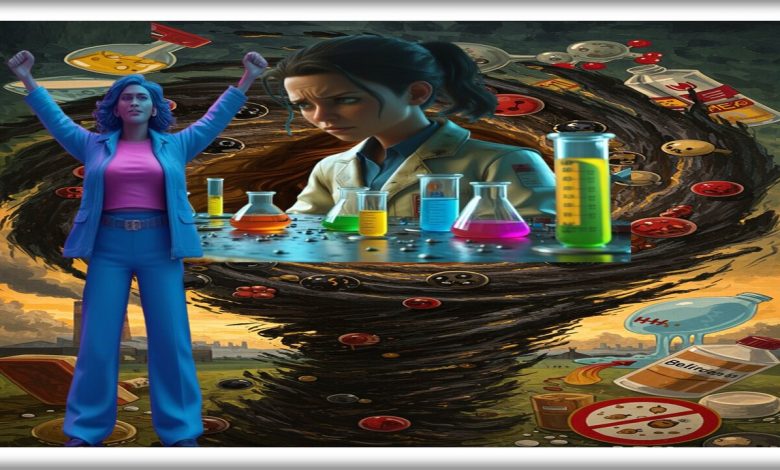Chemicals Threaten Women’s Health: Calls for Equality in a Toxin-Free World

By: Ahmed Abdel Halim
Chemicals have become an integral part of our daily lives, found everywhere from workplaces and factories to homes, schools, and even urban and rural environments. We can no longer escape these substances, which have been discovered in electronics, furniture, clothing, and cleaning and personal care products. However, their widespread presence raises increasing concerns about their negative impacts on human health, especially women’s health. Understanding the relationship between chemicals and women’s health is crucial for achieving a safer and healthier world for everyone.
Studies indicate that thousands of chemicals have toxic effects on human health and the environment, while thousands more remain unknown. Serious health effects have been documented for some highly toxic chemicals, such as persistent organic pollutants and endocrine-disrupting chemicals.
Research shows a significant lack of studies examining the effects of chemicals on men and women separately, as both genders face different social conditions that lead to varying exposures and impacts from hazardous chemicals and waste. This necessitates achieving equality in addressing these risks and ensuring a healthy environment for all, especially women.
Concerns are heightened by our exposure to a mixture of different chemicals, with few tests conducted to assess the combined effects of these substances, which may be more harmful than exposure to a single chemical. Therefore, stakeholders are calling for more research on the impacts of chemicals, focusing on combined effects and gender differences.
The United Nations has emphasized the need for gender equality as a fundamental condition for achieving the Sustainable Development Goals (SDGs) for 2030. A report from the organization noted that the 2030 Agenda for Sustainable Development includes 17 goals, with gender equality (Goal 5) being essential for achieving most of these objectives.
A recent study revealed disparities in women’s sensitivity to chemical exposure, influenced by various factors such as biological and physiological composition, types of occupational exposure, and the use of personal care products. The study confirmed that women face increased risks during critical growth periods, such as pregnancy and breastfeeding.
Research indicates that the effects of chemicals are not limited to women’s health but can also be passed down through generations, particularly when mothers are exposed to these substances during pregnancy or breastfeeding. Consequently, researchers have called for more studies to understand the effects of chemicals on women’s health.
Regarding the impact of chemicals on hormones, some substances pose threats that can disrupt hormonal balance. These substances, known as endocrine-disrupting chemicals (EDCs), are widely used in many consumer products.
Persistent organic pollutants represent a serious threat to the environment and human health, accumulating in the tissues of animals and humans, leading to birth defects and chronic diseases. To address this challenge, governments worldwide adopted the Stockholm Convention in 2002, an international treaty aimed at protecting human health and the environment.
The risks in agriculture and industry are rising, with women making up over 40% of the agricultural workforce in developing countries, exposing them to additional risks due to a lack of education and training. Women working in industrial sectors are also exposed to a mix of hazardous chemicals, necessitating urgent action to protect them.
Recent global studies have revealed pesticide residues in the blood and milk of mothers working in the agricultural sector, raising serious concerns about the health of these women and their children. According to a report from “IPEN” dated August 2, 2023, female agricultural workers in many developing countries face serious health risks. They lack the necessary protective equipment and are not informed about the chemical hazards they encounter. The report indicates that women in agriculture often work long hours for low wages, increasing their exposure to harmful chemicals. Numerous cases have been documented of women suffering from diseases such as cancer, reproductive disorders, and birth defects due to this occupational exposure.
The report calls for the necessary protections for women in agriculture, including the provision of protective equipment, awareness of chemical hazards, and ensuring fair wages.
Another study warns about chemicals threatening women’s health, calling for urgent action on both scientific and political levels. This study emphasizes the need for effective involvement of women in managing chemical issues, with special attention to protecting them as the most at-risk group.
The urgent recommendations provided by the study include:
1. Transparency of Information: The need for clear information to the public about the chemical components of products and their health effects, alongside strict laws to replace harmful substances with safer alternatives.
2. Provision of Detailed Data: Collecting gender-disaggregated data to clarify the differing effects of chemicals on men and women.
3. Critical Policies: Establishing clear policies for the phased elimination of hazardous chemicals that particularly affect women’s health.
The study indicates that women are exposed to chemicals differently than men due to their distinct social roles, making them more vulnerable to risks. It calls on the international community and relevant organizations to take immediate action to protect women’s health from chemical hazards, asserting that this is a fundamental step toward achieving equality and health for all.
There is a growing call among consumers and environmental organizations to hold producers accountable for the products they manufacture, especially those containing harmful chemicals to the environment and human health, particularly for the most vulnerable groups. Consumers are demanding their right to know, insisting on the necessity of disclosing information about the chemical components of products and replacing hazardous materials with safer alternatives.
Environmental organizations stress the importance of producers taking responsibility for the entire lifecycle of their products, from production to final disposal, and working to develop sustainable and safe products for everyone.






